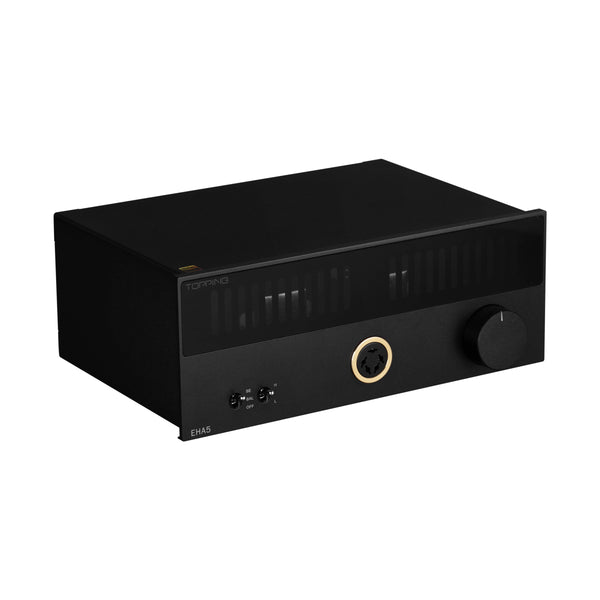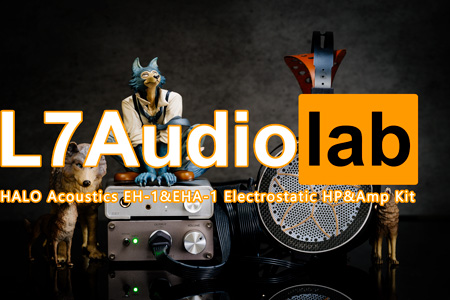-
WANTED: Happy members who like to discuss audio and other topics related to our interest. Desire to learn and share knowledge of science required. There are many reviews of audio hardware and expert members to help answer your questions. Click here to have your audio equipment measured for free!
- Forums
- Audio, Audio, Audio!
- Headphones and Headphone Amplifier Reviews
- Headphone Amplifier Reviews & Discussion
You are using an out of date browser. It may not display this or other websites correctly.
You should upgrade or use an alternative browser.
You should upgrade or use an alternative browser.
Topping estats amp EHA5 (details updated)
- Thread starter okok
- Start date
shrimp_dude
Member
- Joined
- Mar 12, 2020
- Messages
- 80
- Likes
- 69
Is this something confirmed to be in the works?
Laughing Heart
Member
- Joined
- Aug 12, 2021
- Messages
- 18
- Likes
- 28
Where did this rumor come from ?
I would love a reasonably priced Topping alternative, especially when compared to Stax or other specialized and very expensive options.
The choices are limited, I'm very happy with a once reasonably priced but old SRD-7 Mk2 transformer box, it's driven by a Crown Studio Reference II power amp, for my SR-L700's which aren't very expensive, especially when compared to similar priced planar or dynamic headphones, to me this setup sounds better than the top Stax amps, but I've no idea how accurate the setup measures.
I would be happy with a modern Estat Transformer box that is well designed, i.e. a modern take on the SRD-7 Mk2, one that measures accurately.
My 30kg Crown is too big and inconvenient for desktop use,
I'm planning to eventually buy the SABAJ A30a because of it's unique digital feedback design and would expect it to not be affected too much by load or impedance / fequency variables caused by the SRD-7 Mk2 and L700 combination.
Looking forward to what eventates.
I would love a reasonably priced Topping alternative, especially when compared to Stax or other specialized and very expensive options.
The choices are limited, I'm very happy with a once reasonably priced but old SRD-7 Mk2 transformer box, it's driven by a Crown Studio Reference II power amp, for my SR-L700's which aren't very expensive, especially when compared to similar priced planar or dynamic headphones, to me this setup sounds better than the top Stax amps, but I've no idea how accurate the setup measures.
I would be happy with a modern Estat Transformer box that is well designed, i.e. a modern take on the SRD-7 Mk2, one that measures accurately.
My 30kg Crown is too big and inconvenient for desktop use,
I'm planning to eventually buy the SABAJ A30a because of it's unique digital feedback design and would expect it to not be affected too much by load or impedance / fequency variables caused by the SRD-7 Mk2 and L700 combination.
Looking forward to what eventates.
Laughing Heart
Member
- Joined
- Aug 12, 2021
- Messages
- 18
- Likes
- 28
I wouldn't call the iFi iESL cheap, if Topping plans a Transformer Adapter, then great !
but it needs to be a straight transformer adapter without all the bells and whistles of the ifi, no adjustable bias, no adjustable impedance etc, just a straight Stax esl adapter with fixed 580v pro bias supply, and a pair of well designed flat measuring, low noise, low distortion transformers, probably 10 or 15 to 1 ratio, my Stax SRD 7Mk2 has 25 to 1 ratio transformers, these days not necessary as powerful amplifiers are more common, and the lower ratio should measure better with less distortions.
It needs to be well designed when it comes to safety for protection of the headphones connected to it, no one wants their stax headphones fried because of poor implementation.
I think 2 pro bias stax outputs would be good, so you can run 2 stax headphones.
There definitely is a gap in the market for a reasonably priced electrostatic amplifier or transformer adapter, the most expensive part of an adapter would be the two passive transformers, which shouldn't cost excessive and the bias supply which is the only active circuit, it's a simple voltage multiplier that can work on any countries voltage output, again also not expensive to manufacture.
Let's see what happens in 2023.
but it needs to be a straight transformer adapter without all the bells and whistles of the ifi, no adjustable bias, no adjustable impedance etc, just a straight Stax esl adapter with fixed 580v pro bias supply, and a pair of well designed flat measuring, low noise, low distortion transformers, probably 10 or 15 to 1 ratio, my Stax SRD 7Mk2 has 25 to 1 ratio transformers, these days not necessary as powerful amplifiers are more common, and the lower ratio should measure better with less distortions.
It needs to be well designed when it comes to safety for protection of the headphones connected to it, no one wants their stax headphones fried because of poor implementation.
I think 2 pro bias stax outputs would be good, so you can run 2 stax headphones.
There definitely is a gap in the market for a reasonably priced electrostatic amplifier or transformer adapter, the most expensive part of an adapter would be the two passive transformers, which shouldn't cost excessive and the bias supply which is the only active circuit, it's a simple voltage multiplier that can work on any countries voltage output, again also not expensive to manufacture.
Let's see what happens in 2023.
- Thread Starter
- #8
via tw user, everything quoted
details
model name: Topping EHA5
design: transformer
gain: selectable, 40db or 30db (or 28db), lowest gain out there, good for high output level DACs
bias: 580v can't adjust
volume control: like other common topping amps, no relay volume
price: $499 or less, or $449
lights inside: for eyes only, tubes for eyes
sound: every amp sounds the same

details
model name: Topping EHA5
design: transformer
gain: selectable, 40db or 30db (or 28db), lowest gain out there, good for high output level DACs
bias: 580v can't adjust
volume control: like other common topping amps, no relay volume
price: $499 or less, or $449
lights inside: for eyes only, tubes for eyes
sound: every amp sounds the same

TOPPING EHA5
 www.audiosciencereview.com
www.audiosciencereview.com
Jimster480
Major Contributor
Looks cool but not all estats are compatible!
August
Active Member
- Joined
- May 4, 2019
- Messages
- 178
- Likes
- 263
Now available

 apos.audio
apos.audio

TOPPING EHA5 Electrostatic Headphone Amplifier
Unleash the full potential of your electrostatic headphones with the TOPPING EHA5 Electrostatic Headphone Amplifier. Designed to provide exceptional audio performance, this amplifier offers outstanding noise control, impressive power output, and convenient features like a 12V trigger interface...

Halo Acoustics EH-1&EHA-1 Electrostatic HP&Amp Kit - L7Audiolab
台式设备 这个虹曙静电套装( Halo Acoustics EH-1 )是国内两个小鬼做的,记得差不多两年前他们就开始搞这个项目了,当时说的就是要做一个平民化的静电耳机。我其实听着是觉得搞笑的,静电还能平民呐?一个放都得多少钱了?想屁吃?结果果然他们以2999发售了这个套装:
 www.l7audiolab.com
www.l7audiolab.com
Elitzur–Vaidman
Addicted to Fun and Learning
- Joined
- Jul 13, 2022
- Messages
- 508
- Likes
- 537
You keep posting links to that review/product, but it's literally sold out, and there are other electrostats.
Halo Acoustics EH-1&EHA-1 Electrostatic HP&Amp Kit - L7Audiolab
台式设备 这个虹曙静电套装( Halo Acoustics EH-1 )是国内两个小鬼做的,记得差不多两年前他们就开始搞这个项目了,当时说的就是要做一个平民化的静电耳机。我其实听着是觉得搞笑的,静电还能平民呐?一个放都得多少钱了?想屁吃?结果果然他们以2999发售了这个套装:www.l7audiolab.com
According to the information I have learned, it will probably be released in June.You keep posting links to that review/product, but it's literally sold out, and there are other electrostats.
Just want to tell ASR friends that China not only has TOPPING, but Halo Acoustics is also worth paying attention to. Although I know it will be very difficult for audiophiles outside of China to purchase, I still want to share this information.
Their way of specifying the test condition is a bit shady, IMHO. Measuring THD+N with A-weighting? Yeah, the power-line related noise would be conveniently attenuated, so are the higher order harmonics. That could also explain the interesting looking THD+N vs frequency curve, which is pretty much the shape of an inverted A-weighting curve. You can argue 'that 's all you can hear', but comparing numbers needs to be done apple-to-apple.
Also, the 'THD+N@20kBW (No-wt)' is questionable. What does that even mean? THD+N @ 1KHz with 20KHz measurement bandwidth, or THD+N @ 20KHz with an unspecified measurement bandwidth? Either way the result is significantly lower compared to a well-built DIY amp such as the KGSSHV Carbon or Blue Hawaii. The FFT and multi-tone plots are the telltale of the amp's linearity.
The 80uV noise is good but not something worth bragging about, given the low gain of the amp.
Frequency response: 20Hz-40kHz (±2.5dB) means the highest and lowest point across the measurement range can be as large as 5dB apart. Go figure.
The interesting dip between 10kHz and 20kHz on the frequency response curve indicates that they need to do a better job calibrating the high voltage attenuator in front of the AP.
Also, the 'THD+N@20kBW (No-wt)' is questionable. What does that even mean? THD+N @ 1KHz with 20KHz measurement bandwidth, or THD+N @ 20KHz with an unspecified measurement bandwidth? Either way the result is significantly lower compared to a well-built DIY amp such as the KGSSHV Carbon or Blue Hawaii. The FFT and multi-tone plots are the telltale of the amp's linearity.
The 80uV noise is good but not something worth bragging about, given the low gain of the amp.
Frequency response: 20Hz-40kHz (±2.5dB) means the highest and lowest point across the measurement range can be as large as 5dB apart. Go figure.
The interesting dip between 10kHz and 20kHz on the frequency response curve indicates that they need to do a better job calibrating the high voltage attenuator in front of the AP.
Thank you for your analysis! Would this amplifier be clearly inferior to a Blue Hawaii / KGSSHV Carbon? I think it's odd that it uses a small wall-wart versus the other two needing some serious watts from the outlet. However, there could be a situation here where it's analogous to Class D amps; they are measurably superior in every way to big, heavy, and hot Class A or A/B amps barring preferences. I do not know enough about electrostatic amplifier design to understand. I can tell you that my Purifi-based monoblocks sound outstanding, and I'd put them beside any megabuck Class A or A/B monoblocks.Their way of specifying the test condition is a bit shady, IMHO. Measuring THD+N with A-weighting? Yeah, the power-line related noise would be conveniently attenuated, so are the higher order harmonics. That could also explain the interesting looking THD+N vs frequency curve, which is pretty much the shape of an inverted A-weighting curve. You can argue 'that 's all you can hear', but comparing numbers needs to be done apple-to-apple.
Also, the 'THD+N@20kBW (No-wt)' is questionable. What does that even mean? THD+N @ 1KHz with 20KHz measurement bandwidth, or THD+N @ 20KHz with an unspecified measurement bandwidth? Either way the result is significantly lower compared to a well-built DIY amp such as the KGSSHV Carbon or Blue Hawaii. The FFT and multi-tone plots are the telltale of the amp's linearity.
The 80uV noise is good but not something worth bragging about, given the low gain of the amp.
Frequency response: 20Hz-40kHz (±2.5dB) means the highest and lowest point across the measurement range can be as large as 5dB apart. Go figure.
The interesting dip between 10kHz and 20kHz on the frequency response curve indicates that they need to do a better job calibrating the high voltage attenuator in front of the AP.
kevin gilmore
Member
- Joined
- Feb 29, 2020
- Messages
- 54
- Likes
- 261
posted elsewhere direct from the manufacturer.
a90d circuit driving transformers.
a90d circuit driving transformers.
Similar threads
- Replies
- 7
- Views
- 1K
- Replies
- 0
- Views
- 218
- Replies
- 5
- Views
- 1K
- Replies
- 1
- Views
- 561
